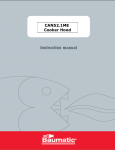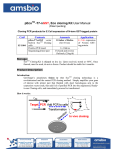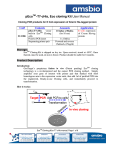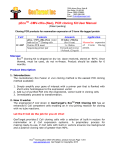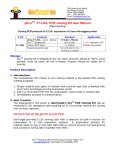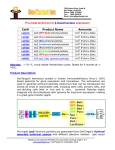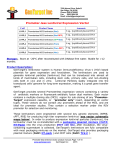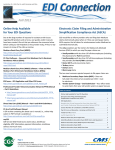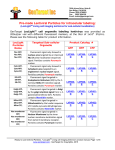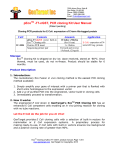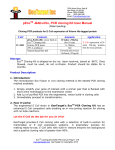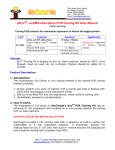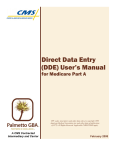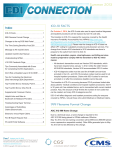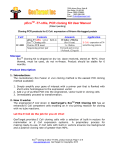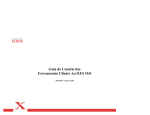Download GenTarget`s EcoTMPlasmid DNA Miniprep Kit User Manual
Transcript
6640 Lusk Blvd. Suite A107 San Diego, CA 92121 Phone: (858) 6788683 Fax: (800) 3804198 Email: [email protected] pEcoTM -ENTRY, Eco PCR cloning Kit User Manual Cloning PCR products for making Gateway Entry clone Cat# Contents Amounts 10 tubes x 50ul/ea (for 10 rxn) IC-1005 pEco-ENTRY vector TM built-in Eco Cloning cells Positive PCR insert Sequencing primer pair 1 x 10ul/ea Forward and reverse 15ul/each, (25ng/ul) Application Make Gateway Entry clone without using BP clonase. Storage: EcoTM Cloning Kit is shipped on dry ice. Upon received, stored at -80°C. Once thawed, must be used, do not re-freeze. Product should be stable for 6 months. Product Description: Introduction: GenTarget’s proprietary fusion in vivo (Patent pending) EcoTM cloning technology is a revolutionized and the easiest PCR cloning method. Simply amplifies your gene of interest with primer pair that flanked with short homologous arm to the expression vector ends, then add 1ul of purified PCR into the engineered, Ready-to-use Cloning cells, and immediately proceed to transformed. How it works: Target PCR Add PCR to cells Transformation n io t In vivo cloning lec e S TM Eco Cloning pEco-ENTRY manual, Page 1 of 7 www.gentarget.com GenTarget Inc Copyrights, 2009 6640 Lusk Blvd. Suite A107 San Diego, CA 92121 Phone: (858) 6788683 Fax: (800) 3804198 Email: [email protected] Gentarget’s EcoTM PCR Cloning Kit utilizes an engineered E Coli strain with enhanced homologous recombination machinery for an In Vivo end-homologous jointing reaction between PCR product and vector. The vector was pre-processed with the cloning cell using a proprietary protocol to obtain high cloning efficiency and low background. It does not need any kinds of In Vitro tube reaction, such as ligation, Topo jointing or In-fusion reaction, and so on. Let the E Coli do the job for you In Vivo! pEco-ENTRY cloning cells was built-in with a Gateway fully compatible ENTRY clone vector. PCR insert will be cloned to make the ENTRY clone that can be used to make any kinds of Gateway DEST clones via a LR reaction. (Note: GenTarget provides Eco cloning cells for making DEST clones also without using LR clonase. And the same PCR product is good for make either ENTRY clone or DEST clone.) Key Features: 1. The most cost effective and the easiest PCR cloning method, simply add 1ul of PCR insert into provided cells for transformation regardless of the insert’s size and concentration; 2. No need to buy Gateway vector. The vector was built-in with cloning cells; 3. No need to buy cloning competent cells. The cloning cells is the competent cells; 4. No need to buy Gateway clonase. There is no need for any enzymes or any tube reactions; 5. Precisely directional cloning of PCR products, making perfect Gateway Entry clones; 6. High efficient (>90% positive rate) and low background; 7. Works fine with any PCR products with or without a 3'-end’s -A overhung (the extra –A overhang, if exists, will be removed in cloning step); 8. Good for different PCR sizes, from 200bp to 6 kb. 9. Great for high through-put cloning; Protocol Outline: Produce PCR products and clean them Add 1~2ul of PCR product into provided Cloning cells, Briefly mixing and immediately proceed to transformation Pick colonies, save glycerol stocks and miniprep plasmids to verify the positive clones TM Eco Cloning pEco-ENTRY manual, Page 2 of 7 www.gentarget.com GenTarget Inc Copyrights, 2009 6640 Lusk Blvd. Suite A107 San Diego, CA 92121 Phone: (858) 6788683 Fax: (800) 3804198 Email: [email protected] Detailed protocols: 1. PCR primer design: The PCR primers, used for generating inserts for EcoTM Cloning must contains a 20 ~ 25bp homologous sequences corresponding to the built-in vector. Design your primer pair as follows: Fwd: 5’- tttgtacaaaaaagcaggcacc + 20bp of (5’end gene specific forward sequence) Rev: 5’- tttgtacaagaaagctgggtt + 20bp of (3’-end gene specific reverse sequence) Protein cleavage site may be included in forward primer to allow removal of the N-term tag if desired. Its codon sequences must be in frame and set between the homologous leader and the 20bp gene specific sequence. An example for PCR primer design: To design the primer pair for the following gene sequence: atggcctctgtgaaggaaaatccactctagtccctacctgcatttctcagccttgcttacctgttg ccaacattgggccaacccgaattcttcccaatctttatcttggctgccagcgagatgtcctcaac aaggagctgatgcagcagaatgggattggttatgtgttaaatgccagcaatacctgtccaaagc ctgacttttta Its PCR primer for vector pEco-ENTRY will be: Fwd: 5’- tttgtacaaaaaagcaggcaccatggcctctgtgaaggaaaa Rev: 5’- tttgtacaagaaagctgggttaaagtcaggctttggacagg Note: 1. Gentarget’s different cloning kits share same PCR Insert. For example, the three EcoTM cloning cells, Cat# IC-1001, IC-1002 and IC-1003 can use the same PCR to make different expression clones. And other three cloning cells (Cat# IC-1005, IC-1006 and IC-1007) can share the same PCR product for making different expression clones. 2. Stop codon is optional to be included in PCR reverse primer. (Note: To express C-term tag protein, do not include a stop codon. So after this ENTR clone is swapped into DEST express vector, the target will be expressed inframe with C-term tag from that DEST vector.) 2. Target amplification by PCR: Using any PCR amplification protocols that work for you to amply your targets. To minimize the PCR errors, we recommend using high fidelity DNA polymerase. Using any PCR purification column to clean your PCR products. If you do not obtain a single, discrete band from your PCR, you need gel-purify your fragment. TM Eco Cloning pEco-ENTRY manual, Page 3 of 7 www.gentarget.com GenTarget Inc Copyrights, 2009 6640 Lusk Blvd. Suite A107 San Diego, CA 92121 Phone: (858) 6788683 Fax: (800) 3804198 Email: [email protected] Important: if your PCR template can generate background clones (having Amp resistance), you need treat your PCR product by DPNI or do gel purification of PCR product. 3. Transformation: Thaw EcoTM Cloning cells in ice-water. After completely thawed, add 1~2ul purified PCR product (from 20ng to 150ng) into each vial of cells, brief mixing by taping the tube with your finger. For control vials, add 1ul positive PCR-insert (provided) as positive control, and add 1ul water to a a negative control vial cells. Put tubes back on ice, and then proceed for heat shock at 42oC for 40 seconds (Note: Do not leave DNA-cells mixture on ice for prolonged period, less than 15min are fine). Put tubes back on ice for 1 min, add 250ul of SOC medium, incubated at 37oC, shaking for 1hr. Plating: take 50ul~200ul aliquot, spread out on pre-warmed LB-agar plates containing 50μg/ml Kanamycin. And grow colonies at 37oC incubator for overnight. Note: usually in the absence of PCR-insert, cells force some background colonies; the no-insert negative control generates a few colonies. But in the presence of PCR-insert, greater than 90% colonies are positive. Colony number varies dependent the quality and quantity of PCR products. The concentration of purified PCR product can be from 20ng/ul to 150ng/ul with sizes from 200bp to 10kb. For the simplicity and high through-put cloning purpose, we recommend simply add 1-2ul of PCR into cloning cells regardless of the PCR’s concentration and sizes, it will generate enough colonies (5 ~ 100 colonies in general) for downstream works. 4. Verification of positive clones: Pick 3-5 colonies, propagate in LB/Kanamycin, incubate at 37oC overnight; Isolate the plasmid DNAs using DNA miniprep kit (such as Eco™ Plasmid DNA Miniprep Kit, Cat# DP-100). Confirm the positive by restriction digestion: PCR inset can be cut out by BsrGI Run 1.2% agarose, two bands: 2.55 kb backbone + the PCR insert (or multiple bands when the sites exist within the PCR-insert). Final sequencing verification: Use provided sequencing primer pair (Note: sequencing primer was provided as ready-to-use dilution, use 1ul for each sequencing reaction with 500ng plasmid in 20ul volume). Cat # IC-1005 Vector pEco-ENTR TM Forward primer IC-1005-fwd 5’- gtaaaacgacggccag Reverse primer IC-1005-rev 5’- taatacgactcactataggg Eco Cloning pEco-ENTRY manual, Page 4 of 7 www.gentarget.com GenTarget Inc Copyrights, 2009 6640 Lusk Blvd. Suite A107 San Diego, CA 92121 Phone: (858) 6788683 Fax: (800) 3804198 Email: [email protected] Vector maps: The figure below summarizes the vector map of pEco-ENTRY. The complete nucleotide sequence is available for downloading from our Website at RESOURCES page (www.gentarget.com). To make your clone map, simply paste your gene sequence (not included the flanking sequences of both ends) in the Red highlighted position (replacing the NNNN..NN). In most case, the pasted sequence is: “ATG…to...last codon”. Cloning site for pEco-ENTRY vector 551 601 651 att L1 AGTCTTAAGC TCGGGCCCCA AATAATGATT TTATTTTGAC TGATAGTGAC TCAGAATTCG AGCCCGGGGT TTATTACTAA AATAAAACTG ACTATCACTG CTGTTCGTTG CAACAAATTG ATGAGCAATG CTTTTTTATA ATGCCAACTT GACAAGCAAC GTTGTTTAAC TACTCGTTAC GAAAAAATAT TACGGTTGAA BsrGI PCR Insert BsrGI TGTACAAAAA AGCAGGCACC NNNNNNNNNA ACCCAGCTTT CTTGTACAAA ACATGTTTTT TCGTCCGTGG NNNNNNNNNT TGGGTCGAAA GAACATGTTT att L2 GTTGGCATTA TAAGAAAGCA TTGCTTATCA ATTTGTTGCA ACGAACAGGT CAACCGTAAT ATTCTTTCGT AACGAATAGT TAAACAACGT TGCTTGTCCA CACTATCAGT CAAAATAAAA TCATTATTTG CCATCCAGCT GATATCCCCT GTGATAGTCA GTTTTATTTT AGTAATAAAC GGTAGGTCGA CTATAGGGGA pEco-ENTRY Vector attL1: 569-668 GOI cloning ends: 670-671 attL2: 771-672 Kanamycin: 941-1750 pUC19 ori: 1871-2544 TM Eco Cloning pEco-ENTRY manual, Page 5 of 7 www.gentarget.com GenTarget Inc Copyrights, 2009 6640 Lusk Blvd. Suite A107 San Diego, CA 92121 Phone: (858) 6788683 Fax: (800) 3804198 Email: [email protected] Trouble shooting: Problems Solution No colony Be sure to set up a positive control transformation using provided positive PCR insert1, which should give you 10~100 colonies; Spread all transformation mixture on plate; Background colonies Be sure to set up a background control plate in which no PCR was added into cells, it should generate 0 ~ 5 colonies or less than 10% compared to plates with insert (Noticed: in the absence of PCR insert, cells forces vector selfligation resulted in a few background colonies). Make sure that the PCR’s template do not cause background colony; If it does, clean PCR products by gelisolation or treated by DPNI; Plate less transformation mixture on plate; Be sure to use right amount of antibiotics in LB plate, and make fresh LB plates if necessary; Do not incubate plates longer than 16 hours; At colony pick, try to avoid the tiny satellite colonies; Satellite colonies Related Products: Cat# DP-100 CC03 CC03p RM1000 EB-S100 EB-L100 Product Name Eco™ Plasmid DNA Miniprep Kit Eco™ E Coli expression Competent Cells Eco™ Expression RichMedium Eco™ Buster E Coli protein extraction reagent Amount 100 miniprep 20 rxn/pack 1000ml/ea 100ml/ea IC-1001 PCR cloning kit kit IC-1002 PCR cloning kit kit TM Application High pure Plamsid DNA isolation Competent cells for T7 vector protein expression Auto-induction, High yield protein expression medium Protein extraction from cell pellets PCR cloning kit with a built-in vector (T7 promoter based) in provided cloning cells for E Coli expression of N-term His-tagged protein. PCR cloning kit with a built-in mammalian expression vector (with neomycin selection marker) in provided cloning cells. The vector containing an engineered super CMV promoter for high-yield mammalian expression of N-term His tagged protein Eco Cloning pEco-ENTRY manual, Page 6 of 7 www.gentarget.com GenTarget Inc Copyrights, 2009 6640 Lusk Blvd. Suite A107 San Diego, CA 92121 Phone: (858) 6788683 Fax: (800) 3804198 Email: [email protected] PCR cloning kit kit IC-1003 IC-1004 PCR cloning kit kit IC-1006 PCR cloning kit kit IC-1007 PCR cloning kit kit PCR cloning kit with a built-in vector (non-T7 promoter based) in provided cloning cells for E Coli expression of N-term His-tagged protein, specially designed for toxic proteins. PCR cloning kit with a built-in vector (T7 promoter based) in provided cloning cells for E Coli expression of N-term GST-tagged protein. PCR cloning kit with a built-in vector (T7 promoter based) in provided cloning cells, for E Coli expression of C-term His-tagged protein. PCR cloning kit with a built-in mammalian expression vector (with Neomycin selection marker) in provided cloning cells, for mammalian expression of C-term His-tagged protein. References: 1. 2. 3. Oliner et al., 1993, Nucleic Acids Res. 1:5192-97 Aslanidis et al., 1994, Genome Res. 4 :172-177 Kaluz et al. Nucl. Acids Res..1992; 20: 4369-4370 TM Eco Cloning pEco-ENTRY manual, Page 7 of 7 www.gentarget.com GenTarget Inc Copyrights, 2009







